Hofmann mustard oil reaction.
Step-by-Step Solution for Hofmann Mustard Oil Reaction
Step 1: Understanding the Reactants
- The Hofmann mustard oil reaction is primarily used to identify primary (1°), secondary (2°), and tertiary (3°) amines. The reaction involves a primary amine reacting with carbon disulfide (CS2) followed by mercuric chloride (HgCl2).
Step 2: Reaction of Primary Amine with CS2
- When a primary amine (R-NH2) reacts with carbon disulfide (CS2), the sulfur atom in CS2 acts as a nucleophile. The nitrogen atom of the amine donates a hydrogen atom to the sulfur, resulting in the formation of a thiourea intermediate.
Reaction:
R−NH2+CS2→R−NH−S−C(=S)−SH
Step 3: Formation of Mustard Oil
- The thiourea intermediate then reacts with mercuric chloride (HgCl2). This step involves the formation of a double bond between nitrogen and carbon, leading to the release of hydrogen sulfide (H2S) and the formation of a compound that has a characteristic smell similar to mustard oil.
Reaction:
R−NH−S−C(=S)−SH+HgCl2→R−N=C=S+H2S+HgS+HCl
Step 4: Identifying the Products
- The final product of this reaction is an isothiocyanate (R-N=C=S), which is responsible for the mustard oil smell.
Step 5: Analyzing Other Amines
- For secondary amines (R2-NH), the reaction with CS2 will yield a similar thiourea product, but upon treatment with HgCl2, the reaction does not proceed to form isothiocyanates.
- Tertiary amines (R3-N) do not react with CS2 at all, thus they do not produce any mustard oil smell.
Summary
- The Hofmann mustard oil reaction is a test for primary amines, where they react with CS2 and HgCl2 to produce isothiocyanates, which smell like mustard oil. Secondary and tertiary amines do not yield this product.
- The Hofmann mustard oil reaction is primarily used to identify primary (1°), secondary (2°), and tertiary (3°) amines. The reaction involves a primary amine reacting with carbon disulfide (CS2) followed by mercuric chloride (HgCl2).
- When a primary amine (R-NH2) reacts with carbon disulfide (CS2), the sulfur atom in CS2 acts as a nucleophile. The nitrogen atom of the amine donates a hydrogen atom to the sulfur, resulting in the formation of a thiourea intermediate.
Reaction:
R−NH2+CS2→R−NH−S−C(=S)−SH
- The thiourea intermediate then reacts with mercuric chloride (HgCl2). This step involves the formation of a double bond between nitrogen and carbon, leading to the release of hydrogen sulfide (H2S) and the formation of a compound that has a characteristic smell similar to mustard oil.
R−NH−S−C(=S)−SH+HgCl2→R−N=C=S+H2S+HgS+HCl
- The final product of this reaction is an isothiocyanate (R-N=C=S), which is responsible for the mustard oil smell.
- For secondary amines (R2-NH), the reaction with CS2 will yield a similar thiourea product, but upon treatment with HgCl2, the reaction does not proceed to form isothiocyanates.
- Tertiary amines (R3-N) do not react with CS2 at all, thus they do not produce any mustard oil smell.
- The Hofmann mustard oil reaction is a test for primary amines, where they react with CS2 and HgCl2 to produce isothiocyanates, which smell like mustard oil. Secondary and tertiary amines do not yield this product.
Topper's Solved these Questions
Similar Questions
A compound (X) has the molecular formula C3H7NO . With Br2 and KOH, (X) gives (Y) . (Y) responds to mustard oil reaction . (Y) upon treatment with HNO2 evolves N2 and gives an alcohol (Z) which gives iodoform test , (X) is likelty to be :
View SolutionWhich of the following undergoes mustard oil reaction ?
View Solution
Knowledge Check
Hofmann broinamide reaction involves the intermediate formation of:
Aa species with electron deficient carbonBa species with electron deficient nitrogenCa species with negative chargeDa free radical species
Hofmann elimination reaction.
View SolutionHofmann elimination reaction.
View SolutionHofmann elimination reaction.
View SolutionHofmann's Bromamide reaction
View SolutionHofmann's Bromamide reaction
View SolutionHofmann's Bromamide reaction
View SolutionRCONH2 is converted into RNH2 by means of Hofmann bromamide degradation.

In this RCONHBr is formed form which this reaction has derived its name. Electron-donating group at phenyl activities the reaction. Hofmann degradation reaction is an intramolecular reaction.
Which is the rate-determining step in Hofmann bromamide degradation ?
View Solution
